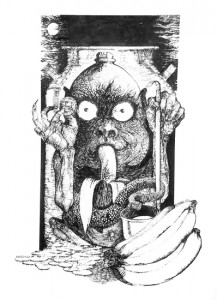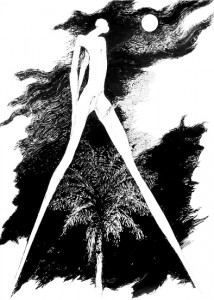Part One

“Cultural Folklore; Celebrating 44” is the theme for Mashramani 2014, Guyana’s celebration of its Republic status attained on Feb. 23, 1970. Cultural folklore has forever captivated the imagination of the country’s writers. Additionally, it has captured the imagination of non-Guyanese writers who, in one way or the other, had experienced the intricacies of Guyana’s cultural patrimony as colonisers, missionaries, or adventurers.
This article, in a series of three parts, will deal with some poetic contributions by Guyanese writers. Another article will look at the contribution by non-Guyanese writers. Finally, a third article will examine the relevancy of cultural folklore to the Guyanese psyche.
Many of the motifs are familiar, some strange and others little known. So let’s start with the familiar and work our way into the esoteric. Let’s start at the beginning with the poem “El Dorado” by A. J. Seymour. The poem tells part of the story of the “City of Gold” which attracted the imagination of all European adventurers, resulting in the colonising of these parts and to sugar, slave, indentureship, independence, and republic.
Juan Martinez, “who came on an expedition to find gold”, witnessed the following:
That morning in reverence priests had anointed him/With sacred and fragrant balsam, then had sprinkled/The dust of gold upon his gleaming skin/He was the gilded one. (Italics)

The “gilded one” was now prepared to make his sacrifice of “emeralds, pearls and gold…then casting his robe aside, the king descended/And washed from him the sacrificial gold.” This annual sacrifice was done in order to reclaim his loved ones from the lake.
From El Dorado, we could move to our first nations. And back to Seymour in his “Legend of Kaieteur” which tells of discord among the first nations and about another sacrifice. Old Kaie, a great chief, sacrificed his life by going over the great falls to seek the will of Makonaima, the great spirit, in order to bring peace to his people.
Kaie then raised his tall/Huge bulk in the boat and towered over the fall/A cruciform over the flaming mist…But of Kaie’s body never showed a trace/He sat with Makonaima before his face.
After the first nations, there were those who came by ships- Portuguese, Chinese, Africans, and Indians among others. They brought their own peculiar cultural folklore- Anancy, Ole Higue, Baccoo, Churile, Moongazer, Yemanji, Ogun, and Balgobin.
Our first sample is “Ole Higue” by Wordsworth McAndrew.
Ol’ woman wid de wrinkled skin,
Leh de ol’ higue wuk begin.
Put on you fiery disguise,
Ol’ woman wid de weary eyes
Shed you swizzly skin.
Find de baby, lif de sheet,
Mek de puncture wid you teet’,
Suck de baby dry.
Whaxen! Whaxen! Whaxen! Plai!
You gwine pay fo’ you sins befo’ you die.
Lash she all across she head
You suck me baby till um dead?
Whaxen! Whaxen! Plai!
You feel de manicole ‘cross you hip?
Beat she till blood start to drip.
“Ow me God! You bruk me hip!
Done now, nuh? Allyou done!”
Is whuh you sayin’ deh, you witch?
Done? Look, allyou beat de bitch.
Whaxen! Whaxen! Pladai! Plai!
Die, you witch you. Die.
Whaxen! Whaxen! Plai!
“Moongaza” by Rooplall Monar is also written in creolese.
Two a’clack ah manin
Moonlight shine
Daag bark
Bow wow wow
Fram de ole loco-line
Memba…
Neighba Stella picknie
Dead blue in she belly
Cause she see Moongaza
Same night dem fowl cack crow
Cook coo roo roo
Memba watchman Djoko?
Drop. Stone dead.
E mule tramp e
Kick e
Mash e
Cause e tek shade foh Moongaza
Me skin raise big!
Ow Moongaza! Moon…Ga…za!
Me picknie! Me picknie!
O Gaad neighba, Lawd!
Moongaza mouth wid blood.
Wait! Don’t run away, there is more of the esoteric in “Maha Kali” by B. Ramsarran.
I am designed to be a symbol of Terror
though there are some who reckon Me differently
I am Maha Kali …
Mother of the universe ..
Shrouded with terrifying esoteric misunderstanding ..
Do you know why many fear My worship?
Of course, we must never diminish the voice of our women writers. Here are two pieces by Grace Nichols- first “Like Anansi” followed by “Yemanji”.
I was the Ashanti spider
Woman-keeper
of dreams
tenacious
opalescent
dark eyes
unblinking
then you came
like Anansi…
not at all
what I was expecting
“Yemanji”
Mother of seas
Goddess of rivers
Mother of Shango
Mother of the long breasts of milk and sorrow
Anancy is not alone. Here comes Balgobin to complement or counter Anancy in “Balgobin Khappah” by Sasenarine Persaud.
Ehem – is me Khappah – Balgobin Khappah/…Well don’t/ ask me how abhi dhis come fuh get dhis name-yuh/know how abhi dhis West Indian staan, always giving/matti falsename but thankyuh thankyuh manijah/fuh dhis oppatunitee…
When last you see a blue moon? Here is “Blue Moon” by Cyril Dabydeen.
The moon turns blue, taking
its life from everything around it
it is flesh of the body
it is the blood vessel
it meets at the limits
of heart and soul
In closing this part of the article, it would be useful to quote from a poem titled “Tradition” by Laxhmie Kallicharan.
Swirling oceans of tradition
distilled as culture
ferment into habit
Responses to this author should be sent to email: oraltradition2002@yahoo.com or call (592) 226-0065.
What’s happening:
Coming soon, the first reprint of “An Introduction to Guyanese Literature”. It will be available from the author at the above contacts, Austin’s Book Service (226-7350) and at the National Library (226-2690).
Part One
|
“C |
ultural Folklore; Celebrating 44” is the theme for Mashramani 2014, Guyana’s celebration of its Republic status attained on Feb. 23, 1970. Cultural folklore has forever captivated the imagination of the country’s writers. Additionally, it has captured the imagination of non-Guyanese writers who, in one way or the other, had experienced the intricacies of Guyana’s cultural patrimony as colonisers, missionaries, or adventurers.
This article, in a series of three parts, will deal with some poetic contributions by Guyanese writers. Another article will look at the contribution by non-Guyanese writers. Finally, a third article will examine the relevancy of cultural folklore to the Guyanese psyche.
Many of the motifs are familiar, some strange and others little known. So let’s start with the familiar and work our way into the esoteric. Let’s start at the beginning with the poem “El Dorado” by A. J. Seymour. The poem tells part of the story of the “City of Gold” which attracted the imagination of all European adventurers, resulting in the colonising of these parts and to sugar, slave, indentureship, independence, and republic.
Juan Martinez, “who came on an expedition to find gold”, witnessed the following:
That morning in reverence priests had anointed him/With sacred and fragrant balsam, then had sprinkled/The dust of gold upon his gleaming skin/He was the gilded one. (Italics)
The “gilded one” was now prepared to make his sacrifice of “emeralds, pearls and gold…then casting his robe aside, the king descended/And washed from him the sacrificial gold.” This annual sacrifice was done in order to reclaim his loved ones from the lake.
From El Dorado, we could move to our first nations. And back to Seymour in his “Legend of Kaieteur” which tells of discord among the first nations and about another sacrifice. Old Kaie, a great chief, sacrificed his life by going over the great falls to seek the will of Makonaima, the great spirit, in order to bring peace to his people.
Kaie then raised his tall/Huge bulk in the boat and towered over the fall/A cruciform over the flaming mist…But of Kaie’s body never showed a trace/He sat with Makonaima before his face.
After the first nations, there were those who came by ships- Portuguese, Chinese, Africans, and Indians among others. They brought their own peculiar cultural folklore- Anancy, Ole Higue, Baccoo, Churile, Moongazer, Yemanji, Ogun, and Balgobin.
Our first sample is “Ole Higue” by Wordsworth McAndrew.
Ol’ woman wid de wrinkled skin,
Leh de ol’ higue wuk begin.
Put on you fiery disguise,
Ol’ woman wid de weary eyes
Shed you swizzly skin.
Find de baby, lif de sheet,
Mek de puncture wid you teet’,
Suck de baby dry.
Whaxen! Whaxen! Whaxen! Plai!
You gwine pay fo’ you sins befo’ you die.
Lash she all across she head
You suck me baby till um dead?
Whaxen! Whaxen! Plai!
You feel de manicole ‘cross you hip?
Beat she till blood start to drip.
“Ow me God! You bruk me hip!
Done now, nuh? Allyou done!”
Is whuh you sayin’ deh, you witch?
Done? Look, allyou beat de bitch.
Whaxen! Whaxen! Pladai! Plai!
Die, you witch you. Die.
Whaxen! Whaxen! Plai!
“Moongaza” by Rooplall Monar is also written in creolese.
Two a’clack ah manin
Moonlight shine
Daag bark
Bow wow wow
Fram de ole loco-line
Memba…
Neighba Stella picknie
Dead blue in she belly
Cause she see Moongaza
Same night dem fowl cack crow
Cook coo roo roo
Memba watchman Djoko?
Drop. Stone dead.
E mule tramp e
Kick e
Mash e
Cause e tek shade foh Moongaza
Me skin raise big!
Ow Moongaza! Moon…Ga…za!
Me picknie! Me picknie!
O Gaad neighba, Lawd!
Moongaza mouth wid blood.
Wait! Don’t run away, there is more of the esoteric in “Maha Kali” by B. Ramsarran.
I am designed to be a symbol of Terror
though there are some who reckon Me differently
I am Maha Kali …
Mother of the universe ..
Shrouded with terrifying esoteric misunderstanding ..
Do you know why many fear My worship?
Of course, we must never diminish the voice of our women writers. Here are two pieces by Grace Nichols- first “Like Anansi” followed by “Yemanji”.
I was the Ashanti spider
Woman-keeper
of dreams
tenacious
opalescent
dark eyes
unblinking
then you came
like Anansi…
not at all
what I was expecting
“Yemanji”
Mother of seas
Goddess of rivers
Mother of Shango
Mother of the long breasts of milk and sorrow
Anancy is not alone. Here comes Balgobin to complement or counter Anancy in “Balgobin Khappah” by Sasenarine Persaud.
Ehem – is me Khappah – Balgobin Khappah/…Well don’t/ ask me how abhi dhis come fuh get dhis name-yuh/know how abhi dhis West Indian staan, always giving/matti falsename but thankyuh thankyuh manijah/fuh dhis oppatunitee…
When last you see a blue moon? Here is “Blue Moon” by Cyril Dabydeen.
The moon turns blue, taking
its life from everything around it
it is flesh of the body
it is the blood vessel
it meets at the limits
of heart and soul
In closing this part of the article, it would be useful to quote from a poem titled “Tradition” by Laxhmie Kallicharan.
Swirling oceans of tradition
distilled as culture
ferment into habit
Responses to this author should be sent to email: oraltradition2002@yahoo.com or call (592) 226-0065.
What’s happening:
Coming soon, the first reprint of “An Introduction to Guyanese Literature”. It will be available from the author at the above contacts, Austin’s Book Service (226-7350) and at the National Library (226-2690).



